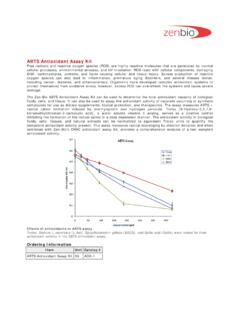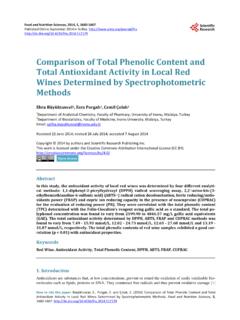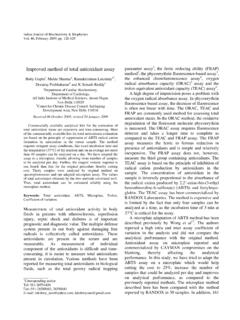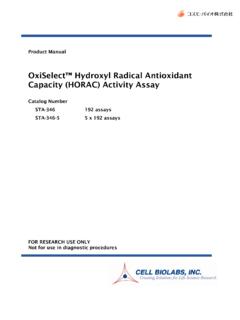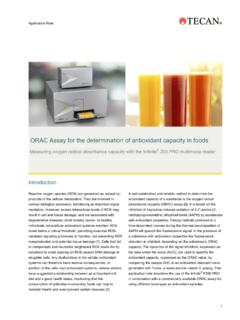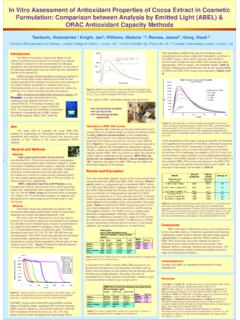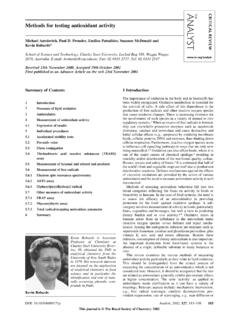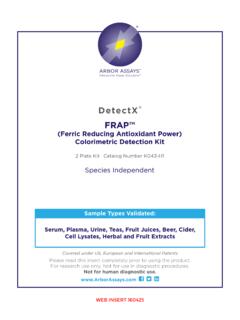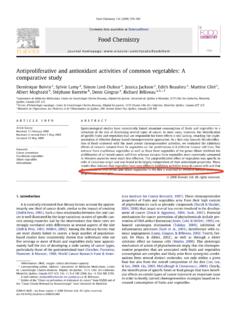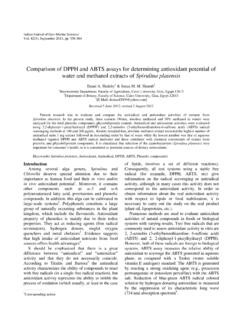Transcription of Antioxidant Activity by DPPH Assay of Potential Solutions ...
1 Braz Dent J 23(1) 2012 Garcia et or carbamide peroxides commonly used for tooth bleaching have been associated with low bond strength values of adhesive restorations placed immediately after bleaching (1). The action mechanism of bleaching agents is based on a complex oxidation reaction,which releases oxygen free radicals that penetrate through the porosities of the enamel prism to the dentin, possibly due to the low molecular weight (about 30 g/mol) of these substances (2). These residual oxidant substances, like oxygen and other free radicals, are reported to interfere with the adhesion of restorative materials and inhibit their adequate polymerization (1).
2 To overcome this problem, several Antioxidant Antioxidant Activity by DPPH Assay of Potential Solutions to be Applied on Bleached TeethEugenio Jos Garcia1 Tatiane Luiza cadorin OLdOni2 Severino Matias de aLEncar2alessandra rEiS3alessandro d. LOGuErciO3rosa Helena Miranda GrandE11 Department of Dental Materials, Dental School, USP - University of S o Paulo, S o Paulo, SP, Brazil2 Department of Agri-Food Industry, Food and Nutrition, Luiz de Queiroz College of Agriculture, USP - University of S o Paulo, Piracicaba, SP, Brazil3 Department of Restorative Dentistry, Dental School, UEPG - State University of Ponta Grossa, Ponta Grossa, PR, BrazilThe aim of this study was to assess, using the dPPH Assay , the Antioxidant Activity of several substances that could be proposed to immediately revert the problems caused by bleaching procedures.
3 The percentage of Antioxidant Activity (aa%) of 10% ascorbic acid solution (aacidS), 10% ascorbic acid gel (aacidG), 10% sodium ascorbate solution (SodasS), 10% sodium ascorbate gel (SodasG), 10% sodium bicarbonate (Bicarb), neutralize (nE), desensibilize (dES), catalase c-40 at 10 mg/mL (caT), 10% alcohol solution of alpha-tocopherol (VitE), Listerine (LiS), chlorhexidine (cHX), Croton Lechleri (cL), 10 % aqueous solution of Uncaria Tomentosa (uT), artificial saliva (artS) and sodium fluoride (naF) was assessed in triplicate by 2,2-diphenyl-1-picryl-hydrazyl-hydrate (dPPH) free radical Assay . all substances exhibited Antioxidant Activity , except for cL.
4 AacidS, aacidG and VitE exhibited the highest aa% (p< ). On the contrary, cHX, nE, LiS and naF showed the lowest aa% (p< ). in conclusion, aacidS, aacidG, SodasS, SodasG and VitE presented the highest Antioxidant Activity among substances tested in this study. The dPPH Assay provides an easy and rapid way to evaluate Potential Words: Antioxidant , dental adhesive, free radical. agents have been proposed, such as sodium ascorbate, ascorbic acid, butylhydroxianisole, catalase, ethanol, acetone, glutathione peroxidise, alpha-tocopherol and sodium bicarbonate (3-6). components of mouthrinses, such as chlorhexidine, essential oils and sodium fluoride, have Antioxidant Activity and have been recommended for prevention of caries and periodontal diseases (7).
5 In the same manner, commercially available products, like catalase at (neutralize , FGM dental Products, Joinville, Sc, Brazil) and 5% potassium nitrate and 2% sodium fluoride (dessensibilize KF 2%; FGM dental Products), which contain Antioxidant compounds, could also be used to increase the bond strength to bleached teeth. due to Antioxidant Activity of naturally occurring correspondence: Profa. dra. rosa Helena Miranda Grande, departamento de Materiais dent rios, FOuSP, avenida Professor Lineu Prestes 2227, cidade universit ria, 05508-000 S o Paulo, SP, Brasil. Tel/Fax: +55-11-3091-7840. e-mail: 0103-6440 Braz Dent J (2012) 23(1): 22-27 Braz Dent J 23(1) 2012 DPPH Assay of Solutions used for bleached teeth23substances in higher plants, attention has increased on the protective Activity of these natural antioxidants against chronic disorders caused by oxidative process.
6 Croton Lechleri (cL) and Uncaria tomentosa (uT) are plants from the amazon river basin widely used for inflammatory disorders and with exhibited Antioxidant and radical scavenging Activity (8,9). although most in vitro studies have used artificial saliva (artS) as a storage medium for bleached teeth prior to bonding procedures (3-6), they have not evaluated or discussed the possible Antioxidant effect of this storage medium on immediately increase bond strength values of bleached teeth. However, to the best of our knowledge, the Antioxidant Activity of these products (commercial products, natural plants and saliva) has not yet been evaluated.
7 Another important point is that, there is lack of standardization regarding the methods used for measure the Potential antioxidants of the substances (8), usually indicated in the literature (1-6).dPPH (2,2-diphenyl-1-picryl-hydrazyl-hydrate) free radical method is an Antioxidant Assay based on electron-transfer that produces a violet solution in ethanol (10). This free radical, stable at room temperature, is reduced in the presence of an Antioxidant molecule, giving rise to colorless ethanol solution. The use of the dPPH Assay provides an easy and rapid way to evaluate antioxidants by spectrophotometry (10), so it can be useful to assess various products at a time.
8 Due to the lack of evidence about which solution can be more effective as an Antioxidant or even if there are other Solutions with equal or more capacity to eliminate free radicals from dental surfaces after bleaching procedures, the purpose of this study was to evaluate the Antioxidant Activity of several agents proposed for reversion of problems caused by bleaching procedures using the dPPH free radical Assay . MATERIAL AND METHODSF ifteen substances were tested: 1) aqueous solution of 10% ascorbic acid (aacidS; Sigma chemical co., St. Louis, MO, uSa; batch#: 91H0179); 2) carbopol gel of 10% ascorbic acid (aacidG); 3) aqueous solution of 10% sodium ascorbate (SodasS; Sigma chemical co.
9 ; batch#: a4034); 4) natrosol gel of 10% sodium ascorbate (SodasG); 5) aqueous solution of 10% sodium bicarbonate (Bicarb; Lase Peroxide Sensy ii ; S o carlos, SP, Brazil; batch#: 413/09); 6) catalase solution (nE; neutralize ; FGM dental Products, batch#: 190608); 7) 5% potassium nitrate and 2% sodium fluoride gel (dES; desensibilize ; FGM dental Products; batch# 250209); 8) aqueous solution of c-40 catalase (10 mg/mL, 16,000 units per milligram of protein) (caT; Sigma chemical co; batch# 037K7022); 9) 10% alpha-tocopherol in ethanol (VitE; Fleming Pharmacy, Ponta Grossa, Pr, Brazil); 10) Listerine (LiS; Johnson & Johnson industrial Ltda.
10 , S o Jos dos campos, SP, Brazil; batch# 1359B06); 11) chlorhexidine digluconate (cHX; Fleming Pharmacy); 12) Viscous latex in natura of Croton Lechleri (cL; World natural, Guayaquil, Equator; batch# y3459); 13) 10% Uncaria Tomentosa aqueous solution (uT; Fleming Pharmacy); 14) artS (1 g sodium carboxymethylcellulose, g xylitol, g potassium chloride, g sodium chloride, mg sodium fluoride, 5 mg magnesium chloride, 5 mg calcium chloride, 40 mg potassium phosphate, 1 mg potassium thiocyanate and 100 g distilled deionized water) (Fleming Pharmacy); 15) sodium fluoride (naF; Fleming Pharmacy). The percentage of Antioxidant Activity (aa%) of each substance was assessed by dPPH free radical Assay .










